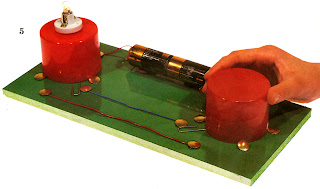Switch Off!
Monday, August 1, 2011
 |
| Switches and Energy |
Switches and Energy
Most modern gadgets, such as kettles and toasters, switch off automatically - this is not only important to conserve energy, but is a safety precaution too. Heating appliances, such as cookers and irons, have thermostats fitted so that a selected
temperature can be maintained - an internal switch turns the heater on or off as required. Because most of our electricity is generated from sources of energy like coal which will run out, we must be aware of the need to save energy whenever possible. The two-way switch is important today, both as a safety device and as a means of conserving energy. If a light can be switched on or off from the top or the bottom of a staircase, not only is it safer at night, but light energy can be saved. Make your own two-way switch and discover how it works.
Switch Off!
Most modern gadgets, such as kettles and toasters, switch off automatically - this is not only important to conserve energy, but is a safety precaution too. Heating appliances, such as cookers and irons, have thermostats fitted so that a selected
temperature can be maintained - an internal switch turns the heater on or off as required. Because most of our electricity is generated from sources of energy like coal which will run out, we must be aware of the need to save energy whenever possible. The two-way switch is important today, both as a safety device and as a means of conserving energy. If a light can be switched on or off from the top or the bottom of a staircase, not only is it safer at night, but light energy can be saved. Make your own two-way switch and discover how it works.
Switch Off!
Position drawing pins at either end of a board so that two plastic lids can just turn, like knobs, within them.
 | ||
| Switch Off 02 |
Align four pins as shown and connect them in pairs with two lengths of wire. Make a hole in the top of one plastic knob and insert the two wires connected to a bulb holder.
 |
| Switch Off 03 |
Connect one wire to a paperclip inserted through the lid, as shown, taking the other to the batteries.
 |
| Switch Off 04 |
Form a switch at the other lid in the same way, connecting the wire to the batteries. Plasticine will hold the wires in place.
WHY IT WORKS
 |
| two-way switch |
 |
| Switch Off |
Check that the paperclips can reach each of the two drawing pins connected to the wires. Rotate the plastic knob, and watch the bulb light up when contact is made. Either ‘knob’ when turned, will turn the light off or on.
Bright ideas
- A person in a wheelchair may need a light switch to be lower down. Design a two-way switch circuit to satisfy this need.
- Build a two-way switch circuit and incorporate it into a card model staircase. Remember that you must incorporate an alternative circuit so that each switch works in two directions. If you increase the distance between the two switches, does it have any effect on the light produced? Do you need an extra battery? Try shortening the distance. Are there any changes?
- Find out how many two-way switches there are in your home or school. Make a record of where they are. Why are they positioned as they are? Identify those places where a two-way switch is needed.

0 comments:
Post a Comment